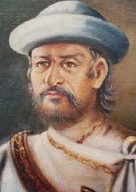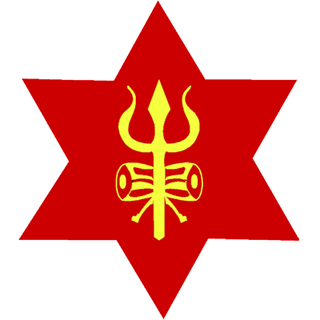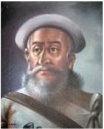Related Research Articles

The Kingdom of Nepal was a Hindu kingdom in South Asia, formed in 1768 by the expansion of the Gorkha Kingdom, which lasted until 2008 when the kingdom became the Federal Democratic Republic of Nepal. It was also known as the Gorkha Empire, or sometimes Asal Hindustan. Founded by King Prithvi Narayan Shah, a Gorkha monarch who claimed to be of Thakuri origin from chaubisi, it existed for 240 years until the abolition of the Nepalese monarchy in 2008. During this period, Nepal was formally under the rule of the Shah dynasty, which exercised varying degrees of power during the kingdom's existence.

Prithvi Narayan Shah, was the last king of the Gorkha Kingdom and first king of the Kingdom of Nepal. Prithvi Narayan Shah started the unification of Nepal.

The Anglo-Nepalese War, also known as the Gorkha War, was fought between the Gorkhali army of the Kingdom of Nepal and the forces of the British East India Company (EIC). Both sides had ambitious expansion plans for the mountainous north of the Indian subcontinent. The war ended with a British victory and the signing of the Treaty of Sugauli in 1816, which ceded some of the Nepalese-controlled territory to the EIC. The British war effort was led by the EIC against the Kingdom of Gorkha. Most of the Kingdom of Gorkha's war effort was led by the two Thapa families: the Thapa dynasty and the family of Amar Singh Thapa.

The Gorkha Kingdom was a member of the Chaubisi rajya, a confederation of 24 states, located at the intersection of Himalayas and the Indian subcontinent. In 1743 CE, the kingdom began a campaign of military expansion, annexing several neighbors and becoming present-day Nepal.

Bhimsen Thapa was a Nepalese statesman who served as the Mukhtiyar and de facto ruler of Nepal from 1806 to 1837. He is widely known as the longest-serving prime minister of Nepal and was inducted into the "National heroes of Nepal" by King Mahendra Bir Bikram Shah.

The Shah dynasty, also known as the Shahs of Gorkha or the Royal House of Gorkha, was the ruling Chaubise Thakuri dynasty and the founder of the Gorkha Kingdom from 1559 to 1768 and later the unified Kingdom of Nepal from 1768 to 28 May 2008.

The unification of Nepal was the process of building the modern Nepalese state, from fractured petty kingdoms including the Baise Rajya and the Chaubisi Rajya, which began in 1743 AD. The prominent figure in the unification campaign was Prithvi Narayan Shah, King of Gorkha. On 25 September 1768, he officially announced the creation of the Kingdom of Nepal and moved his capital from Gorkha to the city of Kathmandu.

Basnyat/Basnet family or Basnyat/Basnet dynasty was a Khas-Chhetri and a warlord clan family involved in the politics and administration of the Gorkha Kingdom and Kingdom of Nepal. This family got entry into Thar Ghar aristocracy group of Gorkha at the time of King Prithvi Narayan Shah. It was one of the four noble families to be involved in active politics of Nepal together with the Shah dynasty, Pande family and the Thapa dynasty before the rise of the Rana dynasty. This family is descended from Shivaram Singh Basnyat, the commander of Gorkhali forces and a member of Shreepali Basnyat clan of Gorkha. This family was maritally linked to Kala (Black) Pande section of the Pande dynasty through Chitravati Pande who married Kaji Kehar Singh Basnyat. This family was the last Kshatriya (Chhetri) political family to be wiped out from the central power by Jung Bahadur Rana of Kunwar family during the Bhandarkhal Massacre in 1846 for the conspiracy to take the power leading to people suffering from 104 long years of the Rana rule.

The Nepali Army, also referred to as the Gorkhali Army, is the land service branch of the Nepali Armed Forces. After the Gorkha Kingdom was founded in 1559, its army was established in 1560, and initially became known as the Gorkhali Army. Later it was known as the Royal Nepali Army (RNA) following the Unification of Nepal, when the Gorkha Kingdom expanded its territory to include the whole country, by conquering and annexing the other states in the region, resulting in the establishment of a single united Hindu monarchy over all of Nepal. It was officially renamed simply to the Nepali Army on 28 May 2008, upon the abolition of the 240-year-old Nepalese monarchy, and of the 449-year-old rule of the Shah dynasty, shortly after the Nepalese Civil War.

Damodar Pande was the Mulkaji of Nepal from 1803 until March 1804 and the most influential Kaji from 1794 to his execution on March 13, 1804. He is also arguably referred to as the first Prime Minister of Nepal. He was the youngest son of famous Kaji of Prithivi Narayan Shah Kalu Pande. He was born in 1752 in Gorkha. Damodar Pande was one of the commanders during the Sino-Nepalese War and in Nepal-Tibet War. He was among the successful Gorkhali warriors sent towards the east by Prithivinarayan Shah.

The Sino-Nepalese War, also known as the Sino-Gorkha War and in Chinese as the campaign of Gorkha, was a war fought between the Qing dynasty of China and the Kingdom of Nepal in the late 18th century following an invasion of Tibet by the Nepalese Gorkhas. It was initially fought between Gorkhas and Tibetan armies in 1788 over a trade dispute related to a long-standing problem of low-quality coins manufactured by Nepal for Tibet. The Nepalese Army under Bahadur Shah plundered Tibet which was a Qing protectorate and Tibetans signed the Treaty of Kerung paying annual tribute to Nepal. However, Tibetans requested Chinese intervention and the Chinese imperial military forces under Fuk'anggan were sent to Tibet and repulsed the Gurkhas from the Tibetan plateau in 1792. Sino-Tibetan forces marched into Nepal up to Nuwakot but faced a strong Nepalese counterattack. Thus, both countries signed the Treaty of Betrawati as a stalemate. The war ended with Nepal accepting terms dictated by China. Nepal became a tribute state under Qing. Nepal paid tribute to China in 1792, 1794, 1795, 1823, 1842 and 1865. Both Nepal and Tibet also agreed to accept the suzerainty of the Qing emperor.

The Shreepali Basnet are a clan of the Chhetris originally from the Saipal, Far West Region who got their prominence in Gorkha district of Nepal. They mainly worship 'Masto' as their 'Kulayan' but saipali from Gorkha has changed their worship to "Sishakoti Mahadev", "Veerabhadra", "Mahakali" as their Kul Deuta and Aradhe Devi "Dakshinkali" as Istha deuta in style of Kunwar Rana. They became very powerful during the unification of Nepal and remained so until the emergence of Jung Bahadur Kunwar or later known as Jang Bahadur Rana.

Rana Jang Pande was the 3rd Prime Minister of the government of Nepal and the most powerful person in political scenario in three decades from the aristocratic Pande clan. He was one of the sons of Mukhtiyar Kaji Damodar Pande. He served as the Prime Minister for two terms, serving 1837–1837 and 1839–1840 AD. He became powerful after Bhimsen Thapa was arrested, and was declared Mukhtiyar and Commander in Chief. He was a grandson of Kaji Kalu Pandey who was the commander of King Prithvi Narayan Shah and the Mulkaji of Gorkha and a notable figure during the unification campaign of Nepal.

Vamshidhar Pande known by Alias Kalu Pande was a Nepalese Brahman/Bahun politician and general who was appointed as Kaji of The Gorkha Kingdom. He was born in 1713 A.D. in a Gorkha family. He was the commander of the Gorkhali forces during the Unification Campaign of Nepal who died in the first Battle of Kirtipur in 1757 A.D. Pande's real name was Banshidhar Pande. He was a son of Kaji Bhimraj Pande who was minister during reign of King Prithivipati Shah of Gorkha. He was descendant of Minister of Gorkha and Dravya Shah's accomplice Ganesh Pande. He had three sons: Dewan Kajisaheb Vamsharaj Pande, Sardar Ranasur Pande and Mulkaji Sahib Damodar Pande.
Sri ChautariaBam Shah or Brahma Shah was an administrator of Nepal. He belongs to Shah Dynasty of Gorkha. He was Governor of Kumaun Province during Anglo-Nepalese war.
Bakhtawar Singh Thapa, also spelled Bhaktawar, was a Nepalese military commander, politician, and governor. He acted as an aide of his brother Mukhtiyar Bhimsen Thapa and was appointed the commander of Samar Jung Company. He commanded the Bijayapur-Sindhuli Gadhi Axis in the first campaign of Anglo-Nepalese War and Makwanpur Gadhi Axis in the second campaign. Later, he became the governor of Palpa and died in the office.
Ranajor Singh Thapa anglicised as Ranjore Thapa was governor of Kumaun and Garhwal and commander of Jaithak Fort during Anglo-Nepalese war at Battle of Jaithak. He was born to General Bada Kaji Amar Singh Thapa. His brother Ranadhoj Thapa served as deputy to Prime Minister Bhimsen Thapa.

The Pande family or Pande dynasty was a Nepali Brahman/Bahun political family that directly ruled Nepali administration, affairs from the 16th century to 19th century as Mulkaji and Mukhtiyar. This dynasty/family was one of the four noble families to be involved in active politics of Nepal together with the Shah dynasty, Basnyat family and Thapa dynasty before the rise of the Rana dynasty. The Pande dynasty is the oldest noble family to hold the title of Kaji. This family was decimated from political power in 1843 CE in the political massacre by Prime Minister Mathabar Singh Thapa as a revenge for his uncle Bhimsen's death in 1839.
The Kunwar family was a noble Khas-Chhetri family in the Gorkha Kingdom and the Kingdom of Nepal. The Kunwars were linked to the Thapa dynasty and family of Amar Singh Thapa by marital lineages and, thus, to Pande dynasty through the Thapa dynasty. Three branches of the Kunwars; Ramakrishna, Jayakrishna and Amar Singh Kunwar were formed with opposite political aspirations. Bal Narsingh Kunwar supported Mukhtiyar Bhimsen Thapa while Chandrabir Kunwar supported Bada Kaji Amar Singh Thapa due to their marital relations with those families. Later, the Ramakrishna section of the family including Amarsingh established the Rana dynasty of Nepal and styled themselves as Rana Rajputs while Jayakrishna most section remained as Kunwars.

The family of Badakaji Amar Singh Thapa was a noble Chhetri family in the central politics of Kingdom of Nepal as well as former military aristocracy of the Gorkha Kingdom. The family of Bhimsen Thapa and the family of Amar Singh Thapa were two Bagale Thapa families and part of the larger Thapa caucus at the central politics of the Kingdom of Nepal.
References
- ↑ [http://www.nepalarmy.mil.np/history.php?page=two > "Nepalese Army | नेपाली सेना"]. nepalarmy.mil.np. Retrieved 2016-10-01.